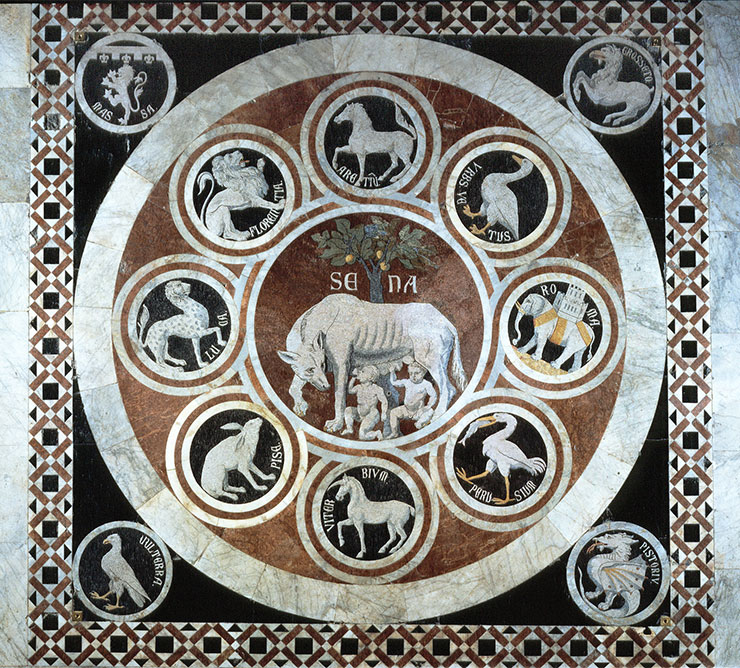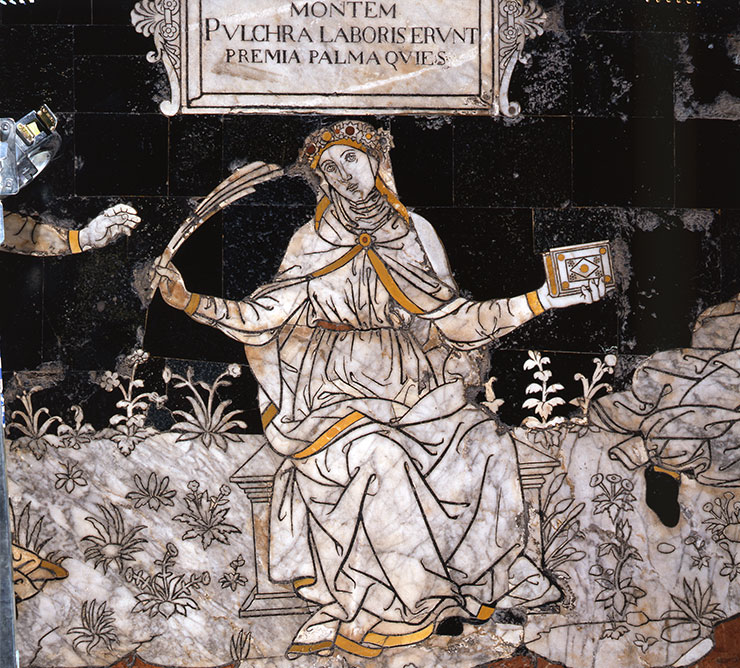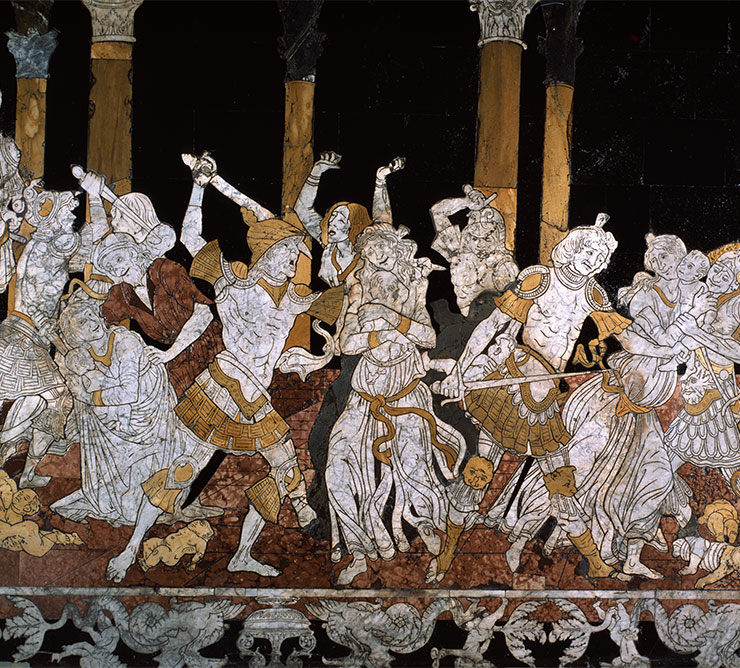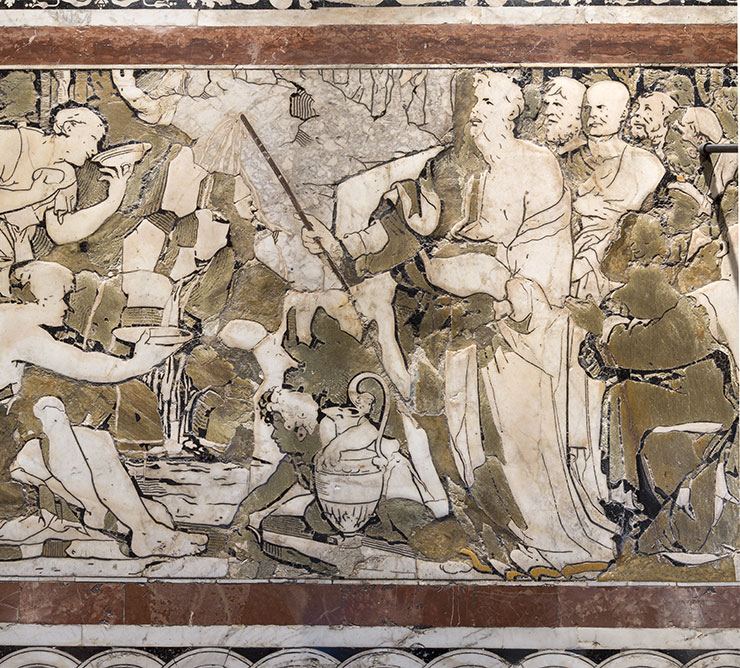EVENTO UNICO: SCOPRI IL PAVIMENTO DEL DUOMO DI SIENA
dal 26 giugno al 31 luglio e dal 18 agosto al 18 ottobre
Durante la visita del pavimento si avrà anche l’opportunità di scoprire i numerosi capolavori d’arte dei quali è ricca la cattedrale di Siena: il celebre pergamo di Nicola Pisano, l’intensa scultura bronzea di San Giovanni Battista realizzata da Donatello, le sculture di Michelangelo realizzate per l’Altare Piccolomini, le statue del Bernini nella Cappella del Voto, nonché la straordinaria Libreria Piccolomini, dove si possono ammirare i celebri affreschi del Pinturicchio raffiguranti la biografia dell’umanista Enea Silvio Piccolomini, poi Papa Pio II. La visita prosegue anche nelle altre sedi museali del Complesso del Duomo: il Museo dell’Opera, dove è custodita la grande Pala d’Altare trecentesca dipinta da Duccio di Buoninsegna raffigurante la Maestà, la Cripta, il Battistero con l’Oratorio di San Bernardino e Museo Diocesano di Arte Sacra.
Il pavimento del Duomo di Siena è il risultato di un complesso programma iconografico realizzato attraverso i secoli, a partire dal Trecento fino all’Ottocento, tarsia dopo tarsia per un totale di cinquantasei tarsie i cui cartoni prepara... more
Il pavimento del Duomo di Siena è il risultato di un complesso programma iconografico realizzato attraverso i secoli, a partire dal Trecento fino all’Ottocento, tarsia dopo tarsia per un totale di cinquantasei tarsie i cui cartoni preparatori furono disegnati da artisti quasi tutti senesi fra cui il Sassetta, Domenico di Bartolo, Matteo di Giovanni, Domenico Beccafumi, oltre che dal pittore umbro Pinturicchio, autore del celebre riquadro con il Monte della Sapienza, raffigurazione simbolica della Via verso la Virtù come raggiungimento della serenità interiore. Il prezioso tappeto di marmi policromi è straordinario, unico non solo per la tecnica utilizzata, ma anche per il messaggio delle figurazioni, un invito costante alla sapienza a partire dalle navate con i protagonisti del mondo antico, scarmigliate sibille e autorevoli filosofi, fino ai soggetti biblici sotto la cupola, nel presbiterio e nel transetto. Il percorso si apre con l’iscrizione d’ingresso davanti al portale centrale, un invito a entrare “castamente” nel Virginis Templum, la casa di Maria, testimonianza del forte legame che i cittadini senesi hanno da secoli con la loro Patrona: Sena vetus civitas Virginis. Subito dopo la scritta, si trova la celebre tarsia con l’Ermete Trismegisto, il sapiente egiziano, il primo grande teologo dell’antichità. Seguono filosofi come Socrate e Cratete nella tarsia del Pinturicchio, Epitteto, Aristotele, Seneca ed Euripide che corredano la Ruota della Fortuna e invitano al distacco dai beni terreni per dedicarsi al pensiero filosofico. Si passa dunque all’itinerario biblico in cui Domenico Beccafumi, rispetto agli artisti delle precedenti generazioni, si avvale di nuovi modi stilistici rinnovando la tecnica del commesso marmoreo.
lessBiglietteria:
Piazza Duomo, 1 - 53100 Siena
Tel.: 0577 286300
Duomo, Museo dell'Opera
e Biblioteca Piccolomini:
Piazza del Duomo
Cripta:
Scalinata di San Giovanni
Battistero:
Piazza San Giovanni
Oratorio di San Bernardino:
Piazza San Francesco
In auto:
Da nord: A1 uscita “Firenze Impruneta”, quindi Superstrada Firenze/Siena (40 min.).
Da sud: A1 uscita “Valdichiana”, quindi raccordo Bettolle-Siena (2h 30min.)
Il Duomo si trova all’interno del Centro Storico della città, non è pertanto consentito raggiungerlo direttamente in auto. Arrivando in auto è consigliabile uscire a Siena Ovest e raggiungere il Parcheggio Duomo, oppure uscire a Siena Sud e raggiungere il Parcheggio Il Campo. Per info: www.sienaparcheggi.it
In treno:
Visita il sito www.trenitalia.com per conoscere gli orari dei collegamenti da Roma, Firenze, Pisa e Grosseto. La Stazione di Siena è in piazza Carlo Rosselli, a circa 2 km dal Centro Storico. Dalla Stazione Ferroviaria al centro il tempo di percorrenza in Bus è di circa 5 minuti (per info: orario autobus urbani).
In Autobus:
Collegamenti dalle grandi città come Roma e Firenze.

The panel is located in the main nave and is the only one made in mosaic. We can admire the she-wolf nursing the twins inside of a circle, to which eight other roundels are connected and which show the emblems of the allied cities.
The she-wolf, which became a symbol of the city of Siena already in medieval times, is linked to the legend of the founding of the city by Senio and Aschio, sons of Remus, who fled from Rome to escape the wrath of their uncle Romulus. In this scene, the fig tree is visible behind the she-wolf; it was there that, according to tradition, the shepherd Faustulus found Romulus and Remus while the she-wolf was nursing them. Collecting the twins, Faustulus took them home and entrusted them to the care of his wife Acca Larenzia.
less
The inlay designed by Pinturicchio (the fourth along the central nave), shows the personification of Fortune towards the bottom of the panel: a naked girl holds the cornucopia with her right hand, while the wind blown sail is raised with her left. Hers is an unstable balance: her right foot rests on a sphere, while her left is placed on an ungovernable boat, the mast of which is broken.
Fortuna, after a stormy journey, managed to land some wise men on a rocky island, walking an uphill path full of pitfalls. On the summit of the mountain, which the wise men try to reach, a female figure is seated: Wisdom or Virtue. The woman offers, with her left hand, a book to Cratete, who gets rid of all fictitious goods by throwing a basket full of jewels into the sea; with her right hand she gives a palm to Socrates. The message of the allegory of the floor is quite evident: the path to Wisdom is arduous, but once the difficult tests have been overcome, serenity is achieved, symbolized by the plateau covered only by flowering bushes.
less
This is the only scene in the floor that refers to an episode from the New Testament (Gospel of Matthew 2:1-18). The inlay evokes a topical event that had befallen the Sienese. In 1480, in fact, while the Duke of Calabria was in Siena, the Turks, who had landed in Otranto, perpetrated a bloody massacre against the citizens, beheading them for not having abjured the Christian faith.

Domenico Beccafumi will perfect the opus sectile technique, combining marbles of different shades in his inlays, obtaining surprising chiaroscuro results, in which lights and shadows outline the figures with such artistic skill, as to seem like masterpieces made with the woodcut technique or monochrome paintings.
Beccafumi accomplished his revolution of the opus sectile technique in the frieze of Moses bringing forth Water out of the Rock, which is inserted between the two pillars that support the dome, towards the presbytery. The main source for the depiction of the scene is a passage from Exodus (17:1-7), in which the people of Israel, after having crossed the Red Sea, are marching towards the promised land, but are suffering from a lack of water, until Moses works a miracle by striking the rock at Horeb, in the presence of the elderly: "the water will flow from it for the people to drink". According to the interpretation of St. Paul, in the first letter to the Corinthians (10:4), the stone represents Christ, from whom salvation flows for those men who draw water from it: "all drank the same spiritual drink, for they drank from a spiritual rock that followed them, and the rock was the Christ".
less